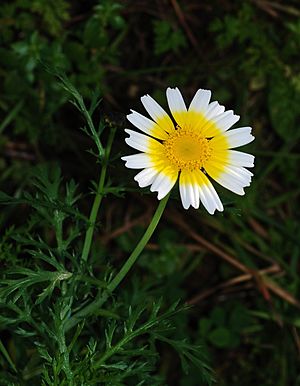Garland chrysanthemum facts for kids
Quick facts for kids Garland chrysanthemum |
|
|---|---|
 |
|
| Scientific classification | |
| Synonyms | |
|
List
|
The Garland chrysanthemum, also known as Glebionis coronaria, is a type of flowering plant. It belongs to the daisy family. This plant was once called Chrysanthemum coronarium.
It originally comes from the Mediterranean area. Today, you can find it growing in East Asia. It also grows in some parts of North America.
People often use Glebionis coronaria as a leaf vegetable. Some common names for it are garland chrysanthemum, chrysanthemum greens, edible chrysanthemum, and crown daisy.
This plant has also been mixed with other related plants. These mixes create new types of garden marguerites.
What Makes It Special?
The garland chrysanthemum is a leafy plant. It grows for only one year, making it an annual plant. Its flowers look like small daisy heads. They have yellow petals around the center.
The leaves are very fragrant. They are also deeply cut into many small parts.
This vegetable grows best in mild or slightly cool weather. If it gets too warm in summer, it will flower too quickly. Farmers usually plant its seeds in early spring or in the fall.
The plant is full of good things for you. It has many minerals and vitamins. For example, it contains lots of potassium and carotene. These are important for your health. The plant also has special compounds called antioxidants. These can help keep your body healthy over time.
Cooking with Garland Chrysanthemum
| Nutritional value per 100 g (3.5 oz) | |
|---|---|
| Energy | 99 kJ (24 kcal) |
|
3.02 g
|
|
| Dietary fiber | 3 g |
|
0.56 g
|
|
|
Protein
|
3.36 g
|
| Vitamins | Quantity
%DV†
|
| Vitamin A equiv.
beta-Carotene
lutein zeaxanthin
|
15%
116 μg
13%
1380 μg3834 μg
|
| Thiamine (B1) |
11%
0.13 mg |
| Riboflavin (B2) |
12%
0.144 mg |
| Niacin (B3) |
4856%
777 mg |
| Pantothenic acid (B5) |
4%
0.221 mg |
| Vitamin B6 |
14%
0.176 mg |
| Folate (B9) |
44%
177 μg |
| Vitamin C |
2%
1.4 mg |
| Vitamin K |
333%
350 μg |
| Minerals | Quantity
%DV†
|
| Calcium |
12%
117 mg |
| Iron |
18%
2.29 mg |
| Magnesium |
9%
32 mg |
| Manganese |
45%
0.943 mg |
| Sodium |
8%
118 mg |
| Zinc |
7%
0.71 mg |
|
Link to USDA Database entry
|
|
| †Percentages estimated using US recommendations for adults. | |
The green leaves of this plant are popular in many Asian dishes. You can find it widely used in China. There, it is called 茼蒿(菜) (tong ho in Cantonese, tónghāo in Mandarin). It is used in many Chinese cuisines. People add it to stir-fries, stews, casseroles, and hotpots.
In Japanese cuisine, it is known as "spring chrysanthemum" (Japanese: 春菊, romanized: shungiku). It is often used in nabemono, which are Japanese hot pot dishes. It can also be mixed into rice. Sometimes, it is served as a side dish with soy sauce and sesame seeds.
Korean cuisine also uses these greens. They are put into soups and stews. They can also be served alone as a side dish called banchan.
In Vietnamese cuisine, the greens are called (Vietnamese: cải cúc) or (Vietnamese: tần ô). They are used in soup (canh). They also come as a side dish with different noodle soups. If you add it to a hotpot, it is best to put it in at the very end. This stops it from cooking too much.
On the island of Crete, a type of this plant is called mantilida. Local people eat its young, tender shoots. They eat them either raw or steamed.
Images for kids
See also
 In Spanish: Glebionis coronaria para niños
In Spanish: Glebionis coronaria para niños











